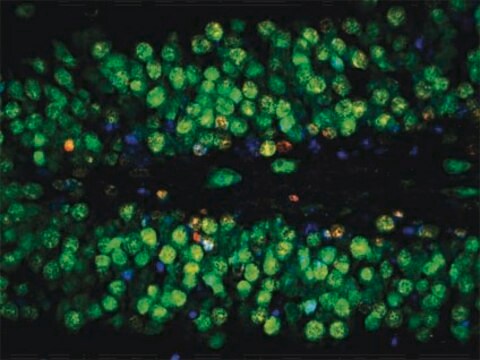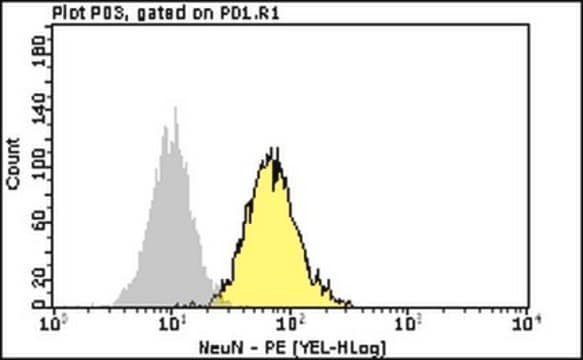FCMAB230P
Milli-Mark® Mouse IgG1-k, clone MOPC-21, PE conjugate
This Milli-Mark Anti-mouse IgG1-PE Antibody, clone MOPC-21 is validated for use in FC for the detection of mouse IgG1.
Se connecterpour consulter vos tarifs contractuels et ceux de votre entreprise/organisme
About This Item
Code UNSPSC :
12352203
eCl@ss :
32160702
Nomenclature NACRES :
NA.41
Produits recommandés
Source biologique
mouse
Niveau de qualité
Conjugué
PE
Forme d'anticorps
purified immunoglobulin
Clone
MOPC-21, monoclonal
Espèces réactives
human
Fabricant/nom de marque
Milli-Mark®
Technique(s)
flow cytometry: suitable
Isotype
IgG1κ
Conditions d'expédition
wet ice
Modification post-traductionnelle de la cible
unmodified
Description générale
The MOPC-21 tumor line that produces mouse IgG1,k, is a mineral oil induced plasmacytoma. The product is originated and carried intraperitoneally in BALB/c mice. Identity and purity of the immunoglobulin is established by immunoelectrophoresis (IEP) and Ouchterlony Double Diffusion (ODD), prior to conjugation. Electrophoresis of the purified immunoglobulin, followed by diffusion versus anti-mouse whole serum, antimouse IgG1 and anti-mouse kappa chain, results in single arcs of precipitation. By ODD the purified immunoglobulin preparation is non-reactive with antisera to mouse lambda light chain, mouse IgA, IgM, IgG2a, IgG2b, and IgG3. The specificity of staining by monoclonal antibodies to human CD antigens should be verified by establishing the amount of non-specific binding to the target cell population. It is recommended that a non-reactive immunoglobulin of the same isotype, concentration and F/P molar ratio be included as a negative control for each monoclonal antibody reagent used in flow cytometry or other immunoassays.
Spécificité
This mouse IgG1 isotype control antibody is not reactive with any known antigen.
Application
Research Category
Inflammation & Immunology
Inflammation & Immunology
Research Sub Category
Isotype Control Antibodies
Isotype Control Antibodies
Qualité
Evaluated for use as flow cytometry isotype control using Jurkat Cells.
Forme physique
Immunoelectrophoresis
Purified mouse monoclonal IgG1κ conjugated to PE in PBS with 0.1% sodium azide and 15 mg/mL BSA.
Stockage et stabilité
Maintain refrigerated at 2-8 °C protected from light in undiluted aliquots for up to 6 months from date of receipt.
Informations légales
MILLI-MARK is a registered trademark of Merck KGaA, Darmstadt, Germany
Clause de non-responsabilité
Unless otherwise stated in our catalog or other company documentation accompanying the product(s), our products are intended for research use only and are not to be used for any other purpose, which includes but is not limited to, unauthorized commercial uses, in vitro diagnostic uses, ex vivo or in vivo therapeutic uses or any type of consumption or application to humans or animals.
Code de la classe de stockage
10 - Combustible liquids
Classe de danger pour l'eau (WGK)
WGK 2
Point d'éclair (°F)
Not applicable
Point d'éclair (°C)
Not applicable
Certificats d'analyse (COA)
Recherchez un Certificats d'analyse (COA) en saisissant le numéro de lot du produit. Les numéros de lot figurent sur l'étiquette du produit après les mots "Lot" ou "Batch".
Déjà en possession de ce produit ?
Retrouvez la documentation relative aux produits que vous avez récemment achetés dans la Bibliothèque de documents.
Robin F Chan et al.
Nucleic acids research, 45(11), e97-e97 (2017-03-24)
Methylome-wide association studies are typically performed using microarray technologies that only assay a very small fraction of the CG methylome and entirely miss two forms of methylation that are common in brain and likely of particular relevance for neuroscience and
Notre équipe de scientifiques dispose d'une expérience dans tous les secteurs de la recherche, notamment en sciences de la vie, science des matériaux, synthèse chimique, chromatographie, analyse et dans de nombreux autres domaines..
Contacter notre Service technique






